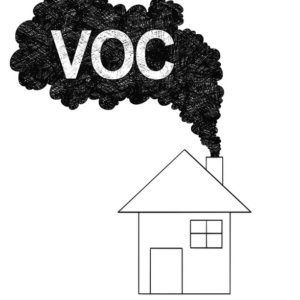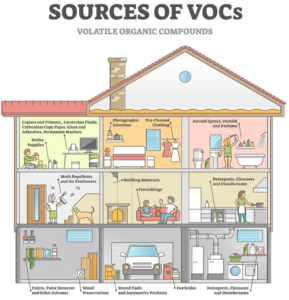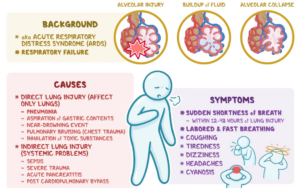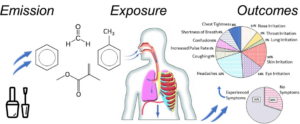Take a deep breath. What do you smell?
If you’re indoors, chances are it’s something “clean”, right? A citrusy surface spray, lavender dryer sheets, pine scented floor cleaner, or a fresh linen air freshener wafting from a plug-in. These smells are marketed as wholesome, safe, and natural. But the reality behind that so-called “freshness” might surprise you.
A groundbreaking study published in Environmental Health Perspectives, led by Anne Steinemann of the University of Washington, analyzed the volatile organic compounds (VOCs) emitted from 25 commonly used scented products. The results were disturbing: more than 100 VOCs were detected, many of which are known to be hazardous or even carcinogenic, yet none were disclosed on product labels.
And yes, that includes products branded as “green,” “natural,” or “organic.”
The VOC Problem: What Are They and Why Should You Care?
 Volatile Organic Compounds (VOCs) are chemicals that easily become vapors or gases at room temperature. They’re emitted by a wide array of everyday items, including paints, cleaning supplies, candles, and a lot of our personal care products. While some VOCs are relatively harmless in small doses, others are linked to serious health issues ranging from headaches and respiratory irritation to hormone disruption and cancer.
Volatile Organic Compounds (VOCs) are chemicals that easily become vapors or gases at room temperature. They’re emitted by a wide array of everyday items, including paints, cleaning supplies, candles, and a lot of our personal care products. While some VOCs are relatively harmless in small doses, others are linked to serious health issues ranging from headaches and respiratory irritation to hormone disruption and cancer.
In Steinemann’s study, 133 different VOCs were identified across the product samples. On average, each product emitted about 17 different VOCs. Common culprits included limonene (a citrus scent), α- and β-pinene (pine scents), ethanol, and acetone. But here’s the kicker – about half of the products emitted at least one of 24 recognized entirely hazardous air pollutants, including formaldehyde, methylene chloride, acetaldehyde, and 1,4-dioxane. According to the U.S. EPA, there is no safe level of exposure for many of these substances.
What’s Lurking Behind “Fragrance”?
One of the most insidious aspects of this problem is the lack of transparency. Only ethanol was listed on the label of two products, and only ethanol and 2-butoxyethanol appeared on Material Safety Data Sheets (MSDS) for a handful more. Yet companies are legally allowed to hide hundreds of chemicals behind the single word: “fragrance.”
This labeling loophole exists because the fragrance industry is largely self-regulated. The U.S. Consumer Product Safety Commission does not require disclosure of fragrance ingredients in cleaning products, air fresheners, or laundry supplies. Likewise, the Food and Drug Administration doesn’t enforce fragrance labeling in personal care products.
So when you spritz that “ocean breeze” room spray, you might actually be inhaling a chemical cocktail that includes neurotoxins, hormone disruptors, and known carcinogens – all under the banner of a “healthy” smell.
Health Effects: From Irritation to Illness
Respiratory Irritation and Asthma
- VOCs like formaldehyde, limonene, and benzene can irritate the respiratory tract.
- In people with asthma or other respiratory conditions, VOC exposure can trigger or worsen symptoms.
- Steinemann’s surveys found that 19% of people experienced respiratory problems when exposed to fragranced products like air fresheners or laundry vents.

“VOCs are known to exacerbate asthma and are associated with increased risk of respiratory symptoms in both children and adults.” – EPA Indoor Air Quality Guide
Neurological Symptoms (Headaches, Dizziness, Cognitive Impairment)
- VOCs such as toluene and xylene are neurotoxic.
- Exposure can cause headaches, dizziness, brain fog, and even loss of coordination.
- Anecdotal evidence from Steinemann’s study includes reports of adults fainting and children having seizures after VOC exposure.
“Short-term exposure to high levels of some VOCs can cause headaches, dizziness, visual disorders, and memory impairment.” – EPA Report on VOCs
Cancer Risk
- Several VOCs are classified as known or probable carcinogens:
- Formaldehyde – linked to nasopharyngeal cancer and leukemia
- Benzene – associated with leukemia
- 1,4-dioxane – liver carcinogen
- Methylene chloride – lung and liver cancer risk
- These are found in fragranced air fresheners, cleaners, candles, and personal care products.
Endocrine Disruption
- Phthalates and other VOCs can act as endocrine-disrupting chemicals (EDCs), mimicking or blocking hormone function.
- Found in synthetic fragrances, EDCs are linked to fertility issues, early puberty, thyroid dysfunction, and metabolic disorders.
“Fragrance formulations in personal care products often contain EDCs that have been associated with altered reproductive development.” – Rudel et al., EHP
Skin and Eye Irritation
- VOCs like acetone, ethanol, and limonene can irritate the eyes, nose, and skin.
- Prolonged exposure or contact (e.g., from personal care items) can lead to dermatitis, burning sensations, or allergic reactions.

“Some VOCs can cause conjunctival irritation, nasal irritation, and allergic skin reactions.” – American Lung Association
Sensitization and Chemical Intolerance (TILT)
- Repeated low-level VOC exposure can lead to Toxicant-Induced Loss of Tolerance (TILT).
- This condition causes people to become hypersensitive to a wide range of environmental chemicals.
- It can manifest as fatigue, pain, cognitive dysfunction, and multi-system sensitivity.
“Once tolerance is lost, low levels of previously tolerated chemicals may elicit symptoms in susceptible individuals.” – Miller & Ashford, TILT Model
Developmental and Reproductive Toxicity
- VOCs like toluene and ethylene glycol ethers are known developmental toxins.
- Exposure during pregnancy can affect fetal growth, neurodevelopment, and increase miscarriage risk.
“Prenatal exposure to certain VOCs has been associated with low birth weight, birth defects, and delayed cognitive development.” – NTP Reports
“Greenwashing” and the Illusion of Safety
Many consumers believe they are making safer choices by buying products labeled “eco-friendly,” “non-toxic,” or “natural.” Unfortunately, these terms are largely unregulated and often meaningless when it comes to chemical safety.
Steinemann’s study found no meaningful difference in the VOC emissions of so-called green products compared to their conventional counterparts. The fragrances were just as complex, and the presence of hazardous compounds just as common.
This form of “greenwashing” deceives well-intentioned consumers into thinking they are making healthier choices, when in fact they may still be exposed to harmful substances.
The Regulatory Black Hole
There is currently no federal law in the United States that requires full disclosure of fragrance ingredients in consumer goods. The Household Product Labeling Act, which would mandate ingredient transparency, including fragrance components, is still under review in the U.S. Senate. Until then, consumers are largely on their own.
fragrance ingredients in consumer goods. The Household Product Labeling Act, which would mandate ingredient transparency, including fragrance components, is still under review in the U.S. Senate. Until then, consumers are largely on their own.
The irony? The push for “freshness” has created an invisible air pollution problem inside our homes, where we spend up to 90% of our time. Indoor air, often assumed to be safer than outdoor air, is in many cases far more polluted due to synthetic fragrance emissions.
We use these synthetic fragrances to cover up natural smells from cooking, compost and trash, kids and pets, and to cover up chemical smells from off-gassing of household products like rugs, mattresses, and clothing. We’re so used to only experiencing “pleasant” smells that we are constantly trying to create artificial aromatic experiences.
What Can You Do?
What if we just adjusted our senses to real smells and tried to breathe fresh, not synthetic air, and also adjusted our standards for what that means?
Here are some steps you can take to improve your indoor air quality and limit your exposure to harmful VOCs:
- Ditch scented products: Opt for fragrance-free (not just “unscented”) versions of cleaning supplies, personal care items, and laundry products. Forget scented candles, and opt for natural fragrance-free ones instead. (Be wary of greenwashing and read labels carefully).
- Use simple ingredients: Vinegar, baking soda, castile soap, and essential oils (these can also be endocrine disruptors, so use cautiously) can be effective alternatives for cleaning.
- Ventilate your space: Open windows when weather and outdoor air quality allow. Use exhaust fans in kitchens and bathrooms.
- Use HEPA and carbon filters: These can help trap both particulate matter and gaseous pollutants, including some VOCs.
- Avoid plug-in air fresheners and scented candles: These are among the worst offenders for VOC emissions.
- Support better legislation: Let your representatives know you care about ingredient transparency and safer consumer products.

Final Thoughts: The Best Smell Is No Smell
We’ve been conditioned by decades of advertising to equate certain smells with cleanliness, health, and comfort, and to expect all smells to be aromatic. But as science catches up, it’s becoming increasingly clear that many of these smells are masking a toxic truth.
The health risks of VOC exposure from everyday fragranced products are real and well-documented, yet strangely underreported and underregulated. These chemicals don’t just make our homes smell nice; they create a hidden form of pollution that we breathe in, absorb through our skin, and store in our bodies. As public awareness grows, so does the call for stricter labeling laws, safer alternatives, and more research into long-term health effects.
As Dr. Miller puts it, “The best smell is no smell.” True cleanliness doesn’t require synthetic fragrances. It requires awareness, intention, and a willingness to challenge the norms we’ve been sold.








